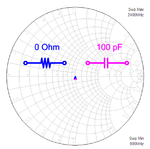Antenna (^.^)
Member level 3
Hi everybody,
I need to use some SPST RF switches for five different frequencies. However it says I need to use DC blocking capacitors for the RF switch to work.
My desired frequencies are 2.4, 2.1, 1.8, 1.6, 0.9 GHz.
Could anyone please give me a starting point on how to determine the values for the DC block capacitors?
I have read about Xc and SRF etc but I am not really getting it....
I need to use some SPST RF switches for five different frequencies. However it says I need to use DC blocking capacitors for the RF switch to work.
My desired frequencies are 2.4, 2.1, 1.8, 1.6, 0.9 GHz.
Could anyone please give me a starting point on how to determine the values for the DC block capacitors?
I have read about Xc and SRF etc but I am not really getting it....
